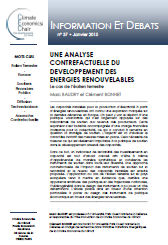
The impacts of introducing a CO2 floor price in the electricity sector
by Christian de Perthuis, Boris Solier, Raphaël Trotignon
Pending a deeper reform of the European CO2 allowances trading scheme (EU ETS), the French government plans to introduce a floor price in 2017 of about €30/tCO2 on electricity sector emissions. Taken unilaterally by France, this measure could be extended to partners who support the approach.
Conducted on the basis of the ZEPHYR-Elec and ZEPHYR-EU ETS models, simulating short-term equilibria in the electricity and CO2 allowance markets, this study aims to assess the impacts of such a €30/tCO2 floor price, applying from 2017.
With the unilateral introduction of this floor price in France, the price of electricity in the wholesale market would increase by €2.6 to €3.4/MWh. The use of French power plants would be reduced in favour of foreign plants, since the option of replacing coal by gas in the domestic supply is limited. It would result in a decrease in national emissions of 3.5 to 9.7 MtCO2. With an unchanged CO2 allowances cap in the European system, the decline in emissions from the French electricity system would cause a slight weakening in the allowance price and increased emissions from actors not affected by the floor price, thus nullifying the intended environmental benefit.
In the event of introducing a European floor price, the price of electricity on the wholesale market would increase by €12/MWh. French thermal power generation, having become more competitive, would increase slightly, limiting the reduction in the country’s emissions. At a European level, the fall in emissions could amount to 124 Mt per year, which would bring down the allowance price to zero. The market system would become a pseudo-tax device generating a net environmental benefit of about 50 Mt less CO2 per year over the period 2017-2020.
In both cases, for a floor price applied to the electric sector to bring the intended environmental benefits, its introduction would need to be accompanied either by in-depth reforms of the European carbon pricing mechanism, or by the introduction of dynamic management of the supply of CO2 allowances, or by switching to a taxation system.
